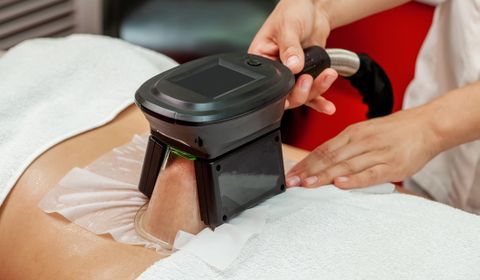Contents
Cryolipolise
A non-invasive aesthetic treatment, cryolipolysis uses cold to destroy adipocytes and thus reduce subcutaneous fat. If it is gaining more and more followers, it has also attracted the attention of health authorities because of its risks.
What is cryolipolise?
Appeared at the end of the 2000s, cryolipolise or coolsculpting, is a non-invasive technique (no anesthesia, no scar, no needle) aimed at attacking, by cold, localized subcutaneous fatty areas. .
According to the promoters of the technique, it is based on the phenomenon of cryo-adipo-apoptosis: by cooling the hypodermis, the fats contained in the adipocytes (fat storage cells) crystallize. The adipocytes would then receive a signal for apoptosis (programmed cell death) and would be destroyed in the following weeks.
How does cryolipolise work?
The procedure takes place in an aesthetic medicine cabinet or aesthetic center, and is not covered by any health insurance.
The person is lying on the table or seated in the treatment chair, the area to be treated bare. The practitioner places an applicator on the fatty area which first sucks up the fatty fold, before cooling it down to -10 °, for 45 to 55 minutes.
The latest generation machines heat the skin before cooling it, then again after cooling for the so-called three-phase machines, in order to create a thermal shock which would increase the results.
The procedure is painless: the patient only feels his skin sucked, then a feeling of cold.
When to use cryolipolise?
Cryolipolise is indicated for people, men or women, not obese, with localized fatty deposits (belly, hip, saddlebags, arms, back, double chin, knees).
Different contraindications exist:
- the pregnancy ;
- an inflamed area, with dermatitis, an injury or a circulatory problem;
- arteritis of the lower limbs;
- Raynaud’s disease;
- an umbilical or inguinal hernia;
- cryoglobulinemia (a disease characterized by the abnormal presence in the blood of proteins that can precipitate in the cold);
- cold urticaria.
Efficacy and risks of cryolipolise
According to the promoters of the technique, a first part (on average 20%) of the fat cells would be affected during the session and evacuated by the lymphatic system. Another part would naturally self-destruct within a few weeks.
However, in its report of December 2016 on the health risks of devices using physical agents intended for the practice of acts with aesthetic purposes, the National Agency for Food, Environmental and Occupational Health Safety ( ANSES) considers that the mechanism on which cryolipolise is based has not yet been formally demonstrated.
Seized by the National Council of the Order of Physicians and the judicial police, the HAS (Haute Autorité de Santé) in turn endeavored to list the adverse effects of cryolipolise in an assessment report. Analysis of the scientific literature has shown the existence of different risks, more or less serious:
- relatively frequent, but mild and short-lived erythema, bruising, pain, numbness or tingling;
- lasting hyperpigmentation;
- vagal discomfort;
- inguinal hernias;
- tissue damage by burning, frostbite or paradoxical hyperplasia.
For these various reasons, the HAS concludes that “ the practice of acts of cryolipolysis presents a suspicion of serious danger to human health in the current absence of implementation of measures to protect human health, consisting at least, on the one hand, of ensuring a uniform level of safety and quality of cryolipolysis devices used and, on the other hand, to provide for the qualification and training of the professional who performs this technique ».










